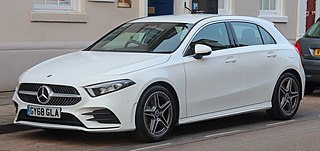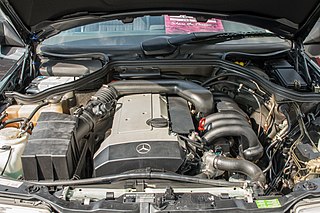
CarlFriedrich Benz was a German engine designer and automotive engineer. His Benz Patent-Motorwagen from 1885 is considered the first practical modern automobile and first car put into series production. He received a patent for the motorcar in 1886, the same year he first publicly drove the Benz Patent-Motorwagen.

The Mercedes-Benz S-Class, formerly known as Sonderklasse, is a series of full-sized luxury sedans and coupés produced by the German automaker Mercedes-Benz. The S-Class is the designation for top-of-the-line Mercedes-Benz models and was officially introduced in 1972 with the W116, and has remained in use ever since. The S-Class is the flagship vehicle for Mercedes-Benz, being positioned above the other Mercedes-Benz models.

The Mercedes-Benz W201 is the internal designation for the Mercedes 190 series sedans, a range of front-engine, rear drive, five passenger, four-door sedans manufactured over a single generation, from 1982 to 1993 as the company's first compact class automobile.

The Mercedes-Benz G-Class, colloquially known as the G-Wagon or G-Wagen, is a four-wheel drive luxury SUV manufactured by Magna Steyr in Graz, Styria, Austria, and sold by Mercedes-Benz. Originally developed as a military off-roader, later more luxurious models were added to the line. In certain markets, it was sold under the Puch name as Puch G until 2000.

The Benz Velo was one of the first cars, introduced by Carl Benz in 1894 as the followup to the Patent-Motorwagen. 67 Benz Velos were built in 1894 and 134 in 1895. The early Velo had a 1L 1.5-metric-horsepower engine, and later a 3-metric-horsepower engine giving a top speed of 19 km/h (12 mph). The Velo was officially introduced by Karl Benz as the Velocipede, and became the world's first standardized serial production car. The Velocipede remained in production between 1894 and 1902, with a final count of over 1,200 produced.

The Mercedes-Benz A-Class is a subcompact car manufactured by Mercedes-Benz and marketed across fourth generations as a front-engine, front-wheel drive, five-passenger, five-door hatchback, with a three-door hatchback offered for the second generation.

The C209/A209 Mercedes-Benz CLK-Class is the second generation of the Mercedes-Benz CLK-Class range of grand tourers, produced between 2001 and 2009. There were two body styles available: a 2-door coupé (C209) and a 2-door convertible (A209). The latter being assembled at the Karmann plant in Osnabrück. It was also the last complete car made by Karmann before closing the facility.

The Mercedes-Benz M104 is a automobile straight-six engine produced from 1988 through 1999. It has a double overhead cam design with 4 valves per cylinder, and used a crossflow cylinder head. It replaced the M103 and was replaced by the M112 V6 starting in 1997. The bore spacing on all M104 engines is the same as M103 engines.

Horch was a German car manufacturer, which traced its roots to several companies founded in the very late 19th and early 20th century by August Horch.

Daimler-Motoren-Gesellschaft was a German engineering company and later automobile manufacturer, in operation from 1890 until 1926. Founded by Gottlieb Daimler (1834–1900) and Wilhelm Maybach (1846–1929), it was based first in Cannstatt. Daimler died in 1900, and their business moved in 1903 to Stuttgart-Untertürkheim after the original factory was destroyed by fire, and again to Berlin in 1922. Other factories were located in Marienfelde and Sindelfingen.

The National Technical Museum (NTM) in Prague is the largest institution dedicated to preserving information and artifacts related to the history of technology in the Czech Republic. The museum has large exhibits representing approximately 15% of its total collection. The museum also manages substantial archives consisting of approximately 3,500 linear shelf meters of archival material and about 250,000 books. The museum was founded in 1908 and has been in its current location since 1941.

The Mercedes-Benz T80 was a six-wheeled vehicle built by Mercedes-Benz, developed and designed by Ferdinand Porsche in the late 1930s. It was intended to break the world land speed record, but never made the attempt, due to the project having been overtaken by the outbreak of World War II.

The Präsident was an automobile manufactured by the Nesselsdorfer Wagenbau-Fabriks-Gesellschaft, since 1919 Tatra, in 1897. It was the first practical, factory-produced petrol engine automobile built in Central and Eastern Europe. It was constructed by Leopold Sviták and Hans Ledwinka. The automobile was more of a carriage without horses than a car in modern sense. The car is steered via handlebars. The wooden bodywork is placed on an iron frame. It has four seats and a convertible top that would cover only the rear seats. Both axles have suspension of semi-elliptical leaf springs. The wheels were similar to the ones of a horse carriage, but had rubber tyres. The car had a two cylinder spark ignition Benz engine placed by the rear axle.

The Mercedes-Benz W31 type G4 was a German three-axle off-road vehicle first produced by Mercedes-Benz as a staff/command car for the Wehrmacht in 1934. The cars were designed as a seven-seat touring car or closed saloon, and were mainly used by upper echelons of the Nazi regime in parades and inspections, as they were deemed too expensive for general Army use.

Société Parisienne was a French manufacturer of velocipedes, bicycles and tricycles from 1876. They began limited automobile construction in 1894 and regular light car (voiturette) construction in 1898 or 1899, and they ceased operation in 1903. The vehicles, variously known as Parisienne, Victoria Combination, Eureka, l'Eclair, Duc-Spider and Duc-Tonneau, were manufactured by Société Parisienne E. Couturier et Cie of Paris.

The adoption of plug-in electric vehicles in Sweden is actively supported by the Government of the Kingdom of Sweden. As of December 2021, a total of 355,737 light-duty plug-in electric vehicles have been registered since 2011, consisting of 226,731 plug-in hybrids, 120,343 all-electric cars, and 8,663 fully electric commercial vans.

Sten Ola Källenius is a Swedish-German business executive. He serves as the Chairman of the Board of Management and CEO of the Mercedes-Benz Group. Källenius was the first non-German to hold both positions prior to obtaining German citizenship.

Ewy Rosqvist-von Korff was one of the most successful ever Swedish rally drivers. She won several European championships, as well as the ladies' classification in Rally to the Midnight Sun. Her most notable accomplishment was the overall win in the Argentine Turismo Standard Grand Prix) in 1962, with Ursula Wirth (1934–2019) as her co-driver.
Hans Nibel was a German mechanical engineer.



![Karl Benz, his family and Baron Theodor von Liebieg [cs] in 1894, on a trip from Mannheim to Gernsheim driving a Benz Victoria and a Vis-a-Vis Benz Patent Motor Car Carl Benz, his family and Theodor Baron von Liebieg in 1894, on a trip from Mannheim to Gernsheim, driving a Benz Vis-a-Vis and a Benz Victoria.jpg](http://upload.wikimedia.org/wikipedia/commons/thumb/8/85/Carl_Benz%2C_his_family_and_Theodor_Baron_von_Liebieg_in_1894%2C_on_a_trip_from_Mannheim_to_Gernsheim%2C_driving_a_Benz_Vis-%C3%A0-Vis_and_a_Benz_Victoria.jpg/220px-Carl_Benz%2C_his_family_and_Theodor_Baron_von_Liebieg_in_1894%2C_on_a_trip_from_Mannheim_to_Gernsheim%2C_driving_a_Benz_Vis-%C3%A0-Vis_and_a_Benz_Victoria.jpg)

















